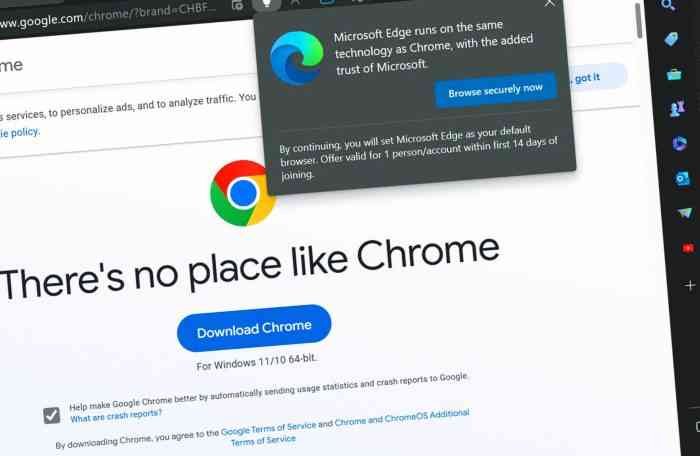Shaping the Search Landscape: A Closer Look at Microsoft’s Strategic Move.
In a recent development that has garnered significant attention, Microsoft has taken a bold step by pausing Bing ads that target users of Google Chrome who have designated Google as their default search engine. This move, notably affecting Windows 11 and 10 users, marks a deliberate shift in Microsoft’s advertising strategy. The surge in Bing and Edge visibility, especially concerning ads appearing above gaming interfaces, suggests a comprehensive effort by the tech giant to encourage users to choose Bing over Google’s search engine in the Chrome environment.
Revamping the Search Experience: A Tactical Approach
Unveiling the Bing Popup
As highlighted earlier, Microsoft’s initiative involved the deployment of a popup notification to Chrome users who have Google or alternative search engines set as their default preference. The pop-up, strategically positioned on the lower right side of the desktop, gained prominence by overlaying applications and games. This innovative advertising technique aimed to remind users of the manifold benefits of utilizing Bing. These advantages encompassed cutting-edge AI chat functionalities and the enticing Microsoft Rewards program.
Temporary Pause and Investigation
Responding to user concerns, Microsoft took cognizance of Bing popup notifications encroaching upon the gaming experience and subsequently decided to pause these advertisements temporarily. The company promptly initiated an investigation into the matter. Subsequent tests revealed that the intrusive Bing popup had been successfully disabled.
A spokesperson from Microsoft acknowledged the situation and indicated that the company is actively probing the issue. The official statement reinforced Microsoft’s commitment to delivering a seamless user experience, indicating that the notification would remain paused during the investigation phase.
Unraveling the Mechanics: The Intricacies Behind the Popup
Deciphering the Popup Mechanism
Further analysis shed light on the mechanics underpinning the Bing popup. The tool responsible for triggering the popup, “BGAUpsell.EXE,” was linked to Microsoft Bing Service 2.0. This underlying background process was designed to enhance the Bing search experience on Windows 11 and 10. Notably, the tool was found to interact with various features where Bing was integrated, including the Windows Search function.
Triggers and Contextual Cues
The popup mechanism appeared to be influenced by certain triggers and contextual cues. References within the tool’s code, such as “IsEdgeUsedInLast48Hours,” suggested that the popup might activate when Microsoft Edge had not been utilized within the past 48 hours. Moreover, the popup’s selective appearance on specific devices hinted at Microsoft’s ability to detect the presence of Google or another search engine active within the Chrome browser.
A Symbiotic Strategy: Microsoft and Advertisements
Strategic Recommendations by Microsoft
Microsoft’s approach of promoting its products, such as Bing and Edge, through targeted advertisements, is not without precedent. The company has consistently employed pop-ups and alerts across the Windows ecosystem to encourage users to explore its offerings. For instance, Microsoft effectively utilized a pop-up within Edge’s address bar to highlight the browser’s technical similarity to Google Chrome, albeit with the added assurance of Microsoft’s trustworthiness.
Unlocking Benefits and Rewards
These advertising endeavors are not limited to software alone. Microsoft’s promotional strategies have extended to showcasing the benefits of Edge usage, with users being enticed by the promise of secure browsing and the opportunity to earn rewards through the Microsoft Rewards program. This approach aims to enhance user engagement and loyalty.
A Parallel Approach: Google’s Strategies
Google’s Counterpart Initiatives
Microsoft’s endeavors are not unique, as Google too employs strategic recommendations within its ecosystem. Users traversing platforms like YouTube, Gmail, and other services using Microsoft Edge often encounter subtle suggestions to switch to Chrome for a presumably enhanced experience. This parallel approach showcases the competitive nature of the tech landscape and highlights the emphasis both industry giants place on capturing user preference and loyalty.
Conclusion
In conclusion, Microsoft’s decision to halt Bing ads for Google Chrome users on Windows 11 reflects a calculated move to influence user behavior and preferences. The temporary pause, pending investigation, demonstrates the company’s commitment to delivering a seamless user experience. This strategic maneuver, accompanied by similar tactics employed by industry counterparts, underlines the significance of capturing user engagement and loyalty in the highly competitive tech landscape. As the search ecosystem continues to evolve, Microsoft’s ability to pivot its advertising strategies will play a pivotal role in shaping user choices and interactions within the digital realm.
